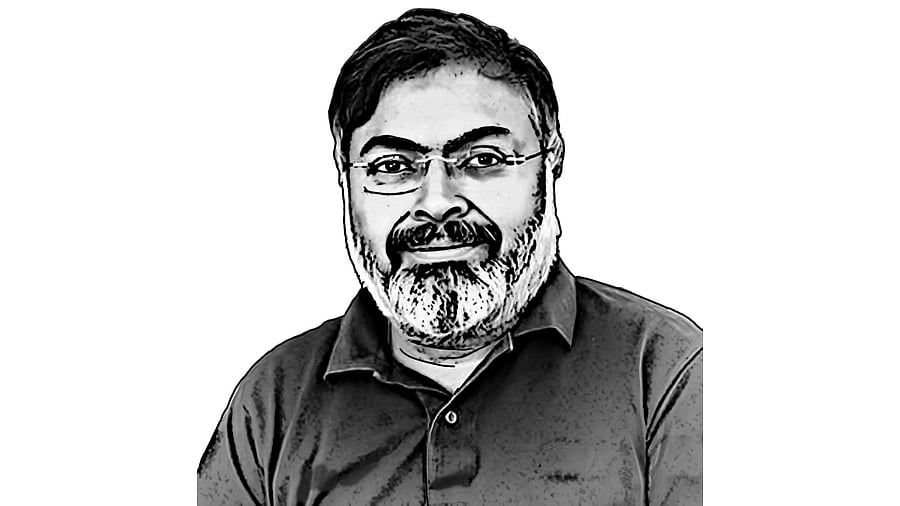
Devdutt Pattanaik works with gods and demons who churn nectar from the ocean of Indian, Chinese, Islamic, Christian, even secular mythologies
In the 12th century, in the Gujarat and Maharashtra region, there was a man called Chakradhar Swami who spoke of devotion to Krishna. His Krishna Bhakti did not involve Radha. It was Advaita and valourised purity and celibacy.
However, according to one highly contested legend, he faced opposition from the local Brahmin community. Under the influence of local Brahmins, the Yadava king sent soldiers to behead him. Chakradhar Swami, however, survived the attack; his headless body reportedly picked up his head, fixed it on the severed neck.
Thus resurrected, he travelled to the Himalayas to become a yogi. Similar tales of confrontation between Bhakti saints and Brahmins are found in different parts of India.
Chaitanya Mahaprabhu, a 15th-century saint from Bengal, was a popular figure who had a large following in Puri, Odisha. His idea of public singing and adoration of Radha was not much appreciated by the local priests, who preferred a more intellectual approach to the divine through sakha bhav (friendship). Chaitanya Mahaprabhu, we are told, merged with the image of Jagannath.
However, his many biographies, written centuries later, offer various explanations: some claim he walked into the sea and disappeared; others suggest he was found outside the temple. There is even a theory that he was attacked and killed by the local Puri Brahmins. None of these theories can be proven, but Chaitanya Mahaprabhu’s death remains a mystery and a source of speculation.
The Marathi saint Tukaram, famous for his abhangas to Pandharpur, the local form of Krishna in Maharashtra, is said to have been bodily taken to Vaikuntha, a concept that appears in many illustrations and films. Is this a metaphor for dying a natural death or a violent one, considering his vernacular poetry faced opposition from the puritans, who believed God’s word should only be presented in Sanskrit?
Mirabai, the great Bhakti poet and Rajput princess, annoyed her Rajput family with her public wanderings and singing. We are told that she also merged with the image of Krishna at Dwarka. What does this mean? Should it be interpreted literally or metaphorically? Feminists argue it could be an instance of honour killing, while the faithful insist it was a spiritual, magical, and miraculous event, unrelated to mundane earthly politics.
The Nayanar saint Nandanar, active as early as the 8th or 9th century in Tamil Nadu, was a low-caste devotee of Shiva. He sang praises and sought access to a Shiva temple. It is said that the only way he could enter was by purifying himself with fire, which he did. Is this a metaphor for being burnt alive or a ritualistic explanation of his transformation and acceptance into the upper caste’s purified realms?
The recurring motif of saints who challenge orthodoxy dying mysterious deaths, performing samadhi (voluntarily leaving their lives at a young age, as in the case of Gyandev), raises questions. Are these stories attempting to communicate something constrained by the censorship of their times? One cannot help but wonder if there is more to these narratives than meets the eye.
Even today, we find different schools of thought vying to dominate the religion. The Sanatani “veg” Dharma is currently trying to claim the supreme position, often with government support. For the first time in history, Hinduism is being taught through the Manusmriti in educational institutions rather than through epic tales, Bhakti poetry or Vedanta philosophy. We are being told that the Vaishnava text, Bhagavad Gita, is the holiest book of Hinduism, mimicking the concept of the holy book of monotheistic religions.
But the Sri Vaishnava brahmins of Srirangam prefer the Vishnu Puran and venerate Garuda, while the Madhva brahmins of Udupi follow the Bhagavata Puran, and venerate Hanuman. The Pushti Margis of Gujarat follow a Hinduism very different from the Swaminarayan Margis, also popular in Gujarat. Hinduism has never been homogeneous. Brahmins in positions of power have sought to impose their way, wiping out alternate ideas, as the history of Bhakti informs us.
This is not unique to Hinduism. The Catholics follow the Pope in Rome. The Orthodox Christians follow leaders in Russia and Greece. Protestants have their own churches. Some Churches allow priests to marry. Some allow same-sex marriage. Some refuse to give women reproductive rights. No one sees eye to eye. Islam has been full of rival schools. The Shias, Sunnis, and Sufis do not agree on many matters, and the violent confrontation continues. Buddhist schools were always quarrelsome. Even the Mauryan emperor Ashoka could not get them to align and agree.
Religion is meant to spiritually elevate us. But it ends up as a political tool. Here, independent thinkers are most feared. Bhakti Hindu saints were the wild mountain goats who walked their own path. The Brahmin shepherds of Hinduism preferred the obedient sheep and cows.